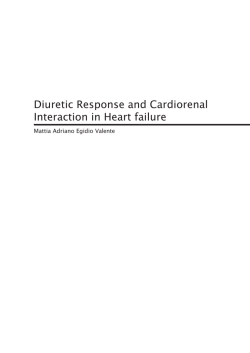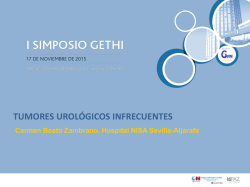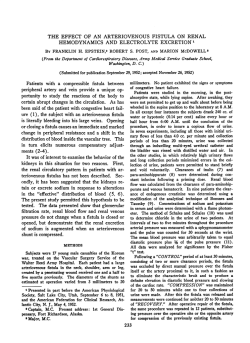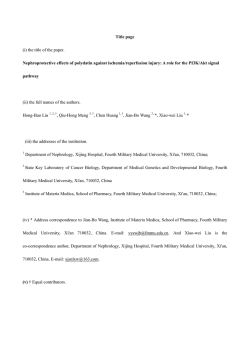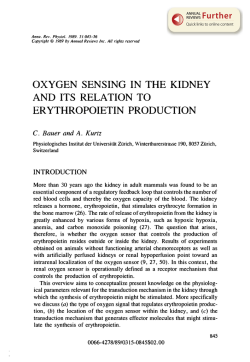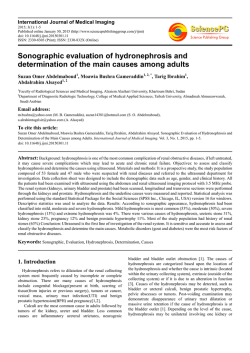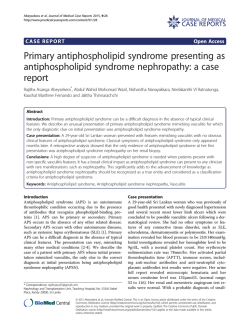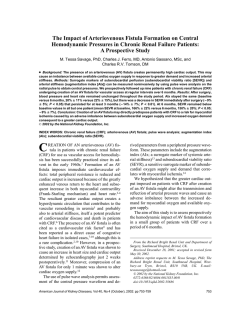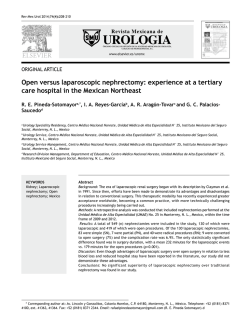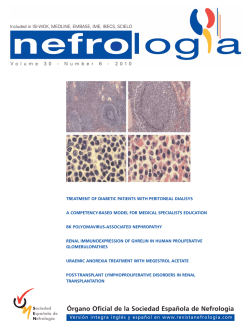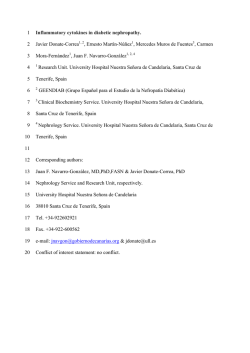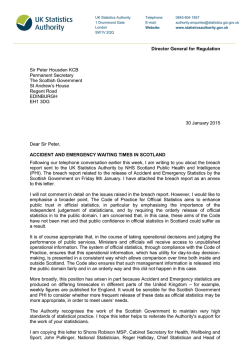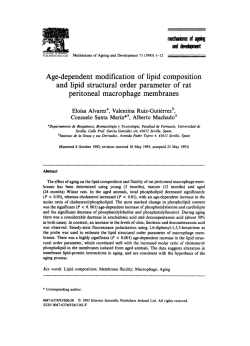
Peritoneal Dialysis to treat Established Renal Failure
SCHEDULE 2 – THE SERVICES A. Service Specifications Service Specification No. A06/S/C Service Peritoneal Dialysis To Treat Established Renal Failure Commissioner Lead Provider Lead Period 12 Months Date of Review 1. Population Needs 1.1 National/local context and evidence base End stage renal failure(ESRF), also known as established renal failure (ERF), is an irreversible, long-term condition as a result of chronic kidney disease for which regular dialysis treatment or transplantation is required if the individual is to survive. If the kidneys fail, the body is unable to excrete certain waste products, excess water, acid and salts resulting in increasing symptoms and eventually death. When ESRF is reached, renal replacement therapy (RRT), in the form of dialysis or transplantation, is required or the person may die within weeks or months. In 2012, 108 patients per million (ppm) population in the UK started RRT for established renal failure but the UK Renal Registry showed significant variation in the crude acceptance rate in England from 59 to 147 ppm. Although some of this variation is explained by ethnicity and socioeconomic deprivation both of which influence the prevalence of kidney disease. To perform peritoneal dialysis the patient is taught to introduce fluid into their peritoneal cavity through a flexible pipe that has been implanted under local or general anaesthetic. This fluid absorbs “toxins” and is then drained away and discarded to be replaced by fresh fluid. Peritoneal dialysis (PD) is long established as a major option for renal replacement therapy in patients with end stage renal disease. It is an important part of an integrated service for renal replacement therapy that is frequently selected by patients as their preferred initial mode of therapy, and is a therapeutic option for patients wishing or needing to swap from haemodialysis (HD) and after renal transplant failure. At the point of commencing renal replacement therapy the incident rate of patients receiving peritoneal dialysis is approximately 20 per million population (pmp) (per year) in England (2011). The prevalence rate of peritoneal dialysis was 60 pmp in England in 2012. The strong presence of Peritoneal Dialysis (PD) in the UK has fallen in the last decade, (first modality PD reduced from 40% to 20%1). . National Institute for Health and Care Excellence (NICE) clinical guidance (CG) 125 notes published evidence supporting the use of PD as first modality, with a suggested uptake if used as first choice for patients with residual renal function or those without significant co-morbidity at 39%. There is wide variation around the country, both in the number of patients on PD, and the types of PD available. Up to 50% of patients, given free choice, will choose PD2. Despite this the percentage of incident dialysis patients treated with PD at ninety days in England ranged from 3% to 47% in England in 20121. At the same time, a population that is increasingly elderly and frail may be restricted to a choice between hospital haemodialysis (HD) and conservative care, when assisted PD, (standard therapy in several countries3,4 , but currently in its infancy in the UK) might be more appropriate. There is also evidence that older people may find PD less intrusive with an improved quality of life in comparison to haemodialysis. 5 1 NEPHRON CLINICAL PRACTICE2013, 125, 1-4,, UK Renal Registry, 16th Annual Report of the Renal Association, UK Renal Registry 2013. 2 Jager K J, Kosevaar J C, Dekker F W, Krediet R T, Boeschoten E W, NECOSAD Study Group. The effect of contraindications and patient preference on dialysis modality selection in ESRD patients in the Netherlands. American Journal of Kidney Disease 2004; 43: 891-899 3 Oliver M J, Quinn R R, Richardson E P, Kiss A J, Lamping D L, Manns B J. Home care assistance and the utilisation of peritoneal dialysis. Kidney International 2007; 71: 673-678 4 Couchoud C, Moranne O, Frimat L, Labeeuw M, Allot V, Stengel B. Associations between comorbidities, treatment choice and outcome in the elderly with end stage renal disease. Nephrology Dialysis Transplantation 2007; 22: 3246-3254 5 Edwina A. Brown, Lina Johansson, Ken Farrington, Hugh Gallagher, Tom Sensky,Fabiana Gordon, Maria Da Silva-Gane, Nigel Beckett and Mary Hickson Broadening Options for Long Term Dialysis in the Elderly (BOLDE) 2010; Nephrol Dial Transplant 25: 3755–3763 Evidence base The National service Framework (NSF) for Renal Services (Department of Health 2004/5) Peritoneal Dialysis. NICE Clinical Guideline 125 (July 2011) Peritoneal Dialysis in CKD. UK Renal Association Clinical Guidelines for Peritoneal Dialysis. UK Renal Association (July 2010) 2. Outcomes 2.1 NHS Outcomes Framework Domains & Indicators Domain 1 Domain 2 Domain 3 Domain 4 Domain 5 Preventing people from dying prematurely √ Enhancing quality of life for people with longterm conditions Helping people to recover from episodes of illhealth or following injury Ensuring people have a positive experience of care Treating and caring for people in safe environment and protecting them from avoidable harm √ √ √ √ A peritoneal dialysis service aims to deliver the following: • • • • • Patient reported outcome and experience measures should be prioritised, and should be the principle barometer of success. Improved quality of life and experience for both patients and carers should be sought (domain 2) Patient-centred and integrated care with equitable provision of service (domain 4) Timely delivery of care in the right place to improve clinical outcomes (domain 3) Improved life expectancy and the prevention of avoidable death from kidney disease (domain 1) in a harm-free environment (domain 5) The pursuit of innovation and value in care offered A service should provide: • • • • • Personalised care, sensitive to the physical, psychological and emotional needs of patients and their families/carers Equity of access and the promotion of patient choice Facilitated autonomy and independent care Where required facilitated transition to end of life care Effective communication and support A service will: • • • Contribute fully to the National Renal Dataset (http://www.ic.nhs.uk/services/datasets/dataset-list/renal) Submit fully to the UK Renal Registry Make Renal Patient View (RPV) available to those who wish to and are able to participate. For those who register with RPV they will be encouraged to advise their GP. Below are listed a number of potential key performance indicators Area Preparation Catheter Insertion Patient Training National/Local Quality Indicator Guidance Renal National Meet NSF Clinical Service Guideline Framework (NSF) Measurable Output Percentage of patients known to service for 90 days starting dialysis with planned access Renal Association Patient Clinical Guidelines satisfaction survey Percentage of patients choosing PD NICE PD guideline Ensure informed patient choice Renal Association/ International Society for PD Guidelines Meet Renal Association clinical guideline All units to have education protocols in place Percentage of patients with functioning catheter at 6 weeks1 Patient satisfaction survey Renal Association Timely first Clinical time treatment Guidelines Adequate training sign-off by 6 weeks Exit site infection rate2 80% of planned PD patients start on PD Number of patients with training signoff at 6 weeks3 Number of patients peritonitis free at 6 weeks4 PD peritonitis rate <1 episode peritonitis in 18 patient months5 Peritonitis free by 6 weeks Maintenance Renal NSF Renal Association Clinical PD technique Guidelines failure rate Number of patients failing PD6 British Renal Society Workforce Planning Report Facility to provide Assisted PD Number of patients on Assisted PD7 1 A functioning catheter is defined as functioning from the first day after successful training is completed 2 An exit site infection is defined according to the 2010 ISPD Guidelines as a ‘purulent drainage from the exit site’ 3 Training is defined as complete on the day after training has been successfully completed. Sign-off at six weeks confirms a patient as competent as trained to perform PD 4 Defined as six weeks from the day after training is successfully completed 5 As defined according to 2010 ISPD Guidelines 6 Where technique survival is defined as the per patient time on PD in months, censored for death, transplantation, transfer out or recovery of renal function 7 Assisted PD is where a paid (usually but not inevitably) unrelated trained carer is necessary to sustain a patient on PD as their chosen modality (and where hospital haemodialysis would otherwise be required) 3. Scope 3.1 Aims and objectives of service The aim of the service is to offer all patients for whom it is clinically appropriate access to all PD treatment modalities. To ensure optimal utilisation of PD as a therapy for endstage renal disease; to set standards for quality of care and outcomes; to maintain availability of the full range of PD products and services and to achieve national consistency across England. The primary objectives will be: Education of patients both in the “pre-dialysis care” and all those established on renal replacement therapy about the option of peritoneal dialysis to manage established renal failure. Timely achievement of peritoneal dialysis access. Patient training that is flexible around patients’ needs. Maintenance of service with clinical support staff with appropriate expertise. Facilitation of patient support by patients. Regular review of patients receiving renal replacement therapy to assess need for change of peritoneal dialysis prescription or need for modality change to haemodialysis and assessment and work up for renal transplantation. Management of the option of withdrawal from dialysis. 3.2 Service description/care pathway Peritoneal dialysis will be delivered in the context of a comprehensive and integrated specialist service for renal replacement therapies, including haemodialysis (with temporary back up facilities), transplantation and conservative care. Continuous ambulatory peritoneal dialysis (CAPD), automated peritoneal dialysis (APD) and assisted PD will be available. The model of a consultant with a particular interest in peritoneal dialysis, supported by other specialists (defined as a competent middle-grade nephrologist with greater than 4 years’ experience or a consultant) with nursing and other staff with primary focus on this group of patients, who are reviewed both in an out-patient environment with access to in patient care and monitoring via a multi-disciplinary team (MDT) will be common to all units. Patients will approach peritoneal dialysis (PD) by various routes, including planned from Renal Clinic, from other parts of the Renal Unit or hospital, from primary care or as an unplanned presentation. Adequate preparation in an accessible setting, shared decision making and education is essential in each scenario, and all Renal units to have on-going analysis of their patient flow onto dialysis. Specialist support, that is patient centred and enables patient choice, will be provided for young adults (age 18-25). This will include those who are in the process of transferring from paediatrics, those who have transferred from paediatrics or those who have come straight into adult services at a young age. Transition will involve a period of joint care from paediatric and adult services and it is important for multi-disciplinary teams (MDTs) to be aware that this group may have additional developmental needs, including educational and employment. Structure Dialysis preparation provided within an integrated specialised renal service, meeting the National Service Framework (NSF) target of education at least one year predialysis, and ensure unbiased access to all treatment modalities. Dedicated competent PD training team as part of an integrated PD service of a size adequate to the PD population, ideally in proximity to pre-dialysis, home haemodialysis and PD maintenance teams. Patient training designed to provide well-educated patients who are able to care for themselves, trained in techniques to help reduce infection and prevent other PD related complications Infrastructure able to offer all PD modalities (CAPD, APD, assisted APD). A tailored pathway option to accommodate non-planned starters. Capacity for home visits and review of home circumstances. Ability to offer peer support by a patient buddy system. Services will be sensitive to the needs of those from all cultures, and appropriate advocacy and translation made available. Anaemia management, including intravenous iron therapy. In line with national guidance, intravenous iron will be delivered in an environment with access to medical equipment that is able to deal with potential side effects and proportionate to the risk of such side effects. Blood transfusion and prescribing erythropoietin stimulating agents (ESAs). People PD to have a senior clinical champion. PD clinicians (nursing, community PD staff, medical and allied health professionals) to work within an MDT to deliver co-ordinated best care. Training for clinicians with an interest in PD against a specified training programme for trainees to gain the required skills to enable safe practice of PD. Access to prompt surgical or radiological intervention for PD problems including need for catheter change, reposition and removal as necessary for access malfunction and infectious complications. Defined links with Microbiology for management of infectious complications and development/modification of local protocols for preventing/managing PD-related infection. Clinical/counselling psychologist and/or counsellor to be available on a case-by-case basis on referral from the MDT, or on request. Training to be offered to patient, family, paid and unpaid carers. Primary care to be informed in the planning process and involved where necessary. Recognition of the unique needs of young people on renal replacement therapy might include peer support groups and/or counselling. Technology IT support, literature, websites and decision aids to reach a consistent standard for content when compared to peer providers. Renal Patient View to be offered to all patients. Catheters, connectology and dialysis fluids chosen according to clinical need and value. There should be access to cycling machines where clinically indicated, and a minimum standard of ancillaries to be agreed, Process Confirm modality decision early to timely insertion of PD catheter7, 10 Catheter insertion to be available in appropriate settings, including operating theatre, radiology departments and clean areas on renal wards. Routine catheter insertion to be performed within two weeks and for an urgent catheter insertion within 24 hours. Catheter insertion should wherever possible be timed to avoid the need for temporary central venous access and haemodialysis. Training to include training in CAPD, APD, assisted APD, post-infection technique reviews and retraining where required. Training to be tailored to all appropriate patient needs and delivered in hospital or at home where practicable. Each patient to have a named carer or team, and an individual care plan – shared and available to all areas, including ward staff. Out-patient care and monitoring should meet the RA guidelines9. To include regular review of markers of technique success and survival, regular clinical and nursing review. Clinics to be available in centre or closer to home, with flexible times to suit working patients and access to the full MDT. As peritoneal dialysis is only one component in the continuum of the renal patient pathway. The monthly MDT review should review the on-going suitability of this dialysis modality. This is the appropriate place to update care plans. The Monthly MDT review will review suitability for transplant listing for all patients not on the transplant list and the suitability for patients so listed to remain on the waiting list. Assisted PD to be readily available to a patient choosing PD whose inability to perform the technique would otherwise require hospital haemodialysis. This to include access to paid carers (including family members) who are supported and regularly trained. Close liaison with local health agencies, hospices, primary care, social workers will be required. Regular review will also be required, as the required level of assistance may change. Advance care planning to include recognition of changes in the patient and the suitability of PD as a modality. This will include increased social support, planned transfer to assisted APD or HD; planned end of life care, if necessary. Dialysis away from home offered in line with a transparent local Unit policy pending the completion of national guidance. Where possible, this should include supply to the patient’s holiday destination within the UK. Allocation will vary on a patient to patient basis7, 13, 14. Costings, which are agreed between renal unit and supplier, to be transparent. Adequate 24/7 arrangements should be in place, with a standard service being available from 9am – 5pm Monday to Friday, and out of hours care available from appropriately trained clinical staff. Prescribing should occur through use of the national formulary, or where no national guidance exists, the locally agreed formulary (including the 'traffic light' arrangement in respect of amber/red drugs) should be recognised. National Specialist Surgery for Encapsulating Peritoneal Sclerosis EPS is a rare but well-recognised complication of PD that occasionally requires specialist surgical management. Patients with suspected EPS should be considered for referral to specialist centres in Manchester and Cambridge. This should occur in a timely and coordinated fashion against agreed protocols 3.3 Population covered The service outlined in this specification is for patients ordinarily resident in England*; or otherwise the commissioning responsibility of the NHS in England (as defined in Who Pays?: Establishing the responsible commissioner and other Department of Health guidance relating to patients entitled to NHS care or exempt from charges). * Note: for the purposes of commissioning health services, this EXCLUDES patients who, whilst resident in England, are registered with a GP Practice in Wales, but INCLUDES patients resident in Wales who are registered with a GP Practice in England. Dialysis services form part of the NHS Commissioning Board’s portfolio of described services and as such are directly commissioned through named local area teams. They would generally serve populations greater than 500,000. 3.4 Any acceptance and exclusion criteria and thresholds This specification refers to adults over the age of 18 years. Some young people aged less than18 years may also be best treated in an adult service, by mutual consent. All patients with end-stage kidney disease should be considered for PD. Special arrangements will be required for young adults (age 18-25 years) to ensure their smooth transition from paediatric services or deal with the additional care needs, including employment and education, for patients newly presenting at this age. Additional support will be patient centred and enable patient choice. Reason for ineligibility should be recorded; this will include patient choice. Prior extensive lower abdominal surgery and morbid obesity, may also represent contraindications to this treatment. Where inappropriate housing is thought to preclude PD, the Renal Unit should consider liaison with the local authority/housing association to encourage re-housing. When treating children, the service will additionally follow the standards and criteria outlined in the Specification for Children’s services (attached as Annex A to this specification) 3.5 Interdependencies with other services/providers Co-located services Co-located at training site for PD Interdependent Services Medical cover for emergencies Pathology Surgical and Intervention radiology procedures Psycho-social support Pharmacy services Vascular access Nutrition and dietetic services Anaemia management Hepatitis B vaccination Social care & work advice, including that relating to benefits Related Services General Practitioners and community services General Practitioners with Special Interests Secondary provider clinicians and specialist nurses Specialist transplant provider’s Patient transport services Medical Physics renal technical teams NHS estates staff Environmental waste service Many people with CKD also have other medical conditions, particularly diabetes, depression and cardiac conditions. It is therefore essential that strong clinical linkages are made with other services, preferably with care provided from a multi-disciplinary team setting. The provider will work directly with, but not limited to, the following professionals to ensure a seamless service: General Practitioners and community services General Practitioners with Special Interest Secondary provider clinicians and specialist nurses Specialist transplant providers Patient Transport Services 4. Applicable Service Standards 4.1 Applicable national standards e.g. NICE The provider is expected to comply with the legislative provisions of renal replacement therapy and the Care Standards Act (2000), and to provide services in accordance with regulations as defined by, but not limited to, the following authorities and organisations which may change over time: Regulatory bodies and legislation Care Quality Commission and any successor organisations; and All applicable law on Health and Safety at work Anti-discrimination and equal opportunities legislation General Medical Council Professional bodies with an interest and national guidance Renal Association Clinical Practice Guideline for Peritoneal Dialysis 2011 Renal Association Clinical Practice Guideline for Peritoneal access January 2009 UK Renal Registry British Renal Society British Transplantation Society including all relevant clinical practice guidelines National and local health service bodies and relevant local government authorities Strategic Clinical Networks NICE guideline: Peritoneal Dialysis. July 2011 NICE guideline Anaemia management in people with chronic kidney disease 2011. NHS Employment Check Standards CNST General Clinical Risk management standard appropriate to the service being delivered; National Service Framework for Renal Services Royal College of Physicians Clinical Standards for Renal Services NICE guidance 4.2 Applicable standards set out in Guidance and/or issued by a competent body (e.g. Royal Colleges) 5. Applicable quality requirements and CQUIN goals 5.1 Applicable quality requirements (See Schedule 4 Parts A-D) 5.2 Applicable CQUIN goals (See Schedule 4 Part E) 6. Location of Provider Premises The Provider’s Premises are located at: Appendix 1 Quality standards specific to the service using the following template Quality Requirement Threshold Method of Measurement Consequence of breach Domain 1: Preventing people dying prematurely For all suitable patients to have option of having peritoneal dialysis Benchmark followed by actions plans for improvement if proportion of peritoneal dialysis patients is in lower quartile of national performance % of patients receiving peritoneal dialysis as a % of all dialysis patients. Annual audit. As per Standard NHS Contract General Conditions Clause 9 (GC9) Remedial Action Plan Domain 2: Enhancing the quality of life of people with long-term conditions To increase the number of patients accessing peritoneal dialysis. Benchmark followed by actions plans for improvement if proportion of peritoneal dialysis patients is in lower quartile of national performance Access to Benchmark assisted followed by peritoneal dialysis action plans for improvement if proportion is in lower quartile of % of patients receiving peritoneal dialysis as a % of all dialysis RRT patients Annual audit % of assisted peritoneal patients as a % of all peritoneal patients. As per Standard NHS Contract General Conditions Clause 9 (GC9) Remedial Action Plan Quality Requirement Threshold Method of Measurement national performance Annual audit Consequence of breach Domain 3: Helping people to recover from episodes of ill-health or following injury To ensure patients are informed and involved in their care. Benchmark followed by action plans for improvement. % of patients who complete education/training programme including repeat sessions/further education. Proportion of patients with training sign-off at 6 weeks. As per Standard NHS Contract General Conditions Clause 9 (GC9) Remedial Action Plan Annual Audit. Domain 4: Ensuring that people have a positive experience of care To ensure informed patient choice and to be involved in shared decision making Benchmark to be followed by evidence of improvement. 80% of planned PD patients to start on PD. Annual Audit: 1.Patients and carers survey on quality of service together with satisfaction with choice of RRT and patient reported health related quality of life. 2. Number and % of patients with access and instruction in the use of Renal Patient View. 3. Number and % of patients utilising shared decision making aids/actively involved in shared decision making. As per Standard NHS Contract General Conditions Clause 9 (GC9) Remedial Action Plan Quality Requirement Threshold Method of Measurement Consequence of breach 4. evidence of education protocols within unit. Domain 5: Treating and caring for people in a safe environment and protecting them from avoidable harm To have relevant MDT and services available to support and ensure the safety of the patient. <1 episode of peritonitis in 18 patient months of treatment. Evidence of MDT and service available, including arrangements for 24/7 cover. % of patients with functioning catheter at 6 weeks. % of patients peritonitis free at 6 weeks. Number of peritonitis episodes. Exit site infection rate Annual audit. ANNEX 1 TO SERVICE SPECIFICATION: As per Standard NHS Contract General Conditions Clause 9 (GC9) Remedial Action Plan PROVISION OF SERVICES TO CHILDREN Aims and objectives of service This specification annex applies to all children’s services and outlines generic standards and outcomes that would fundamental to all services. • The generic aspects of care: The Care of Children in Hospital (Health Service Circular (HSC) 1998/238) requires that: o Children are admitted to hospital only if the care they require cannot be as well provided at home, in a day clinic or on a day basis in hospital. o Children requiring admission to hospital are provided with a high standard of medical, nursing and therapeutic care to facilitate speedy recovery and minimize complications and mortality. o Families with children have easy access to hospital facilities for children without needing to travel significantly further than to other similar amenities. o Children are discharged from hospital as soon as socially and clinically appropriate and full support provided for subsequent home or day care. o Good child health care is shared with parents/carers and they are closely involved in the care of their children at all times unless, exceptionally, this is not in the best interest of the child; Accommodation is provided for them to remain with their children overnight if they so wish. Service description/care pathway • All paediatric specialised services have a component of primary, secondary, tertiary and even quaternary elements. • The efficient and effective delivery of services requires children to receive their care as close to home as possible dependent on the phase of their disease. • Services should therefore be organised and delivered through “integrated pathways of care” (National Service Framework for children, young people and maternity services (Department of Health (DOH) & Department for Education and Skills, London 2004) Interdependencies with other services All services will comply with Commissioning Safe and Sustainable Specialised Paediatric Services: A Framework of Critical Inter-Dependencies – DOH Imaging o All services will be supported by a 3 tier imaging network (‘Delivering quality imaging services for children’ DOH 13732 March2010). Within the network; It will be clearly defined which imaging test or interventional procedure can be performed and reported at each site Robust procedures will be in place for image transfer for review by a specialist radiologist, these will be supported by appropriate contractual and information governance arrangements Robust arrangements will be in place for patient transfer if more complex imaging or intervention is required Common standards, protocols and governance procedures will exist throughout the network. All radiologists, and radiographers will have appropriate training, supervision and access to Continuing Professional Development (CPD) All equipment will be optimised for paediatric use and use specific paediatric software • Specialist Paediatric Anaesthesia o Wherever and whenever children undergo anaesthesia and surgery, their particular needs must be recognised and they should be managed in separate facilities, and looked after by staff with appropriate experience and training.1 All UK anaesthetists undergo training which provides them with the competencies to care for older babies and children with relatively straightforward surgical conditions and without major co-morbidity. However those working in specialist centres must have undergone additional (specialist) training2 and should maintain the competencies so acquired3 *. These competencies include the care of very young/premature babies, the care of babies and children undergoing complex surgery and/or those with major/complex co-morbidity (including those already requiring intensive care support). o As well as providing an essential co-dependent service for surgery, specialist anaesthesia and sedation services may be required to facilitate radiological procedures and interventions (for example MRI scans and percutaneous nephrostomy) and medical interventions (for example joint injection and intrathecal chemotherapy), and for assistance with vascular access in babies and children with complex needs such as intravenous feeding. o Specialist acute pain services for babies and children are organised within existing departments of paediatric anaesthesia and include the provision of agreed (hospital wide) guidance for acute pain, the safe administration of complex analgesia regimes including epidural analgesia, and the daily input of specialist anaesthetists and acute pain nurses with expertise in paediatrics. *The Safe and Sustainable reviews of paediatric cardiac and neuro- sciences in England have noted the need for additional training and maintenance of competencies by specialist anaesthetists in both fields of practice. o References 1. Guidelines on the Provision of Anaesthetic Services (GPAS) Paediatric anaesthetic services. Royal College of Anaesthetists (RCoA) 2010 www.rcoa.ac.uk 2. Certificate of Completion of Training (CCT) in Anaesthesia 2010 3. CPD matrix level 3 Specialised Child and Adolescent Mental Health Services (CAMHS) The age profile of children and young people admitted to specialised CAMHS day/inpatient settings is different to the age profile for paediatric units in that it is predominantly adolescents who are admitted to specialised CAMHS in-patient settings, including over-16s. The average length of stay is longer for admissions to mental health units. Children and young people in specialised CAMHS day/inpatient settings generally participate in a structured programme of education and therapeutic activities during their admission. Taking account of the differences in patient profiles the principles and standards set out in this specification apply with modifications to the recommendations regarding the following o Facilities and environment – essential Quality Network for In-patient CAMHS (QNIC) standards should apply (http://www.rcpsych.ac.uk/quality/quality,accreditationaudit/qnic1.aspx) o Staffing profiles and training - essential QNIC standards should apply. o The child/ young person’s family are allowed to visit at any time of day taking account of the child / young persons need to participate in therapeutic activities and education as well as any safeguarding concerns. o Children and young people are offered appropriate education from the point of admission. o Parents/carers are involved in the child/young persons care except where this is not in the best interests of the child / young person and in the case of young people who have the capacity to make their own decisions is subject to their consent. o Parents/carers who wish to stay overnight are provided with accessible accommodation unless there are safeguarding concerns or this is not in the best interests of the child/ young person. Applicable national standards e.g. NICE, Royal College Children and young people must receive care, treatment and support by staff registered by the Nursing and Midwifery Council on the parts of their register that permit a nurse to work with children (Outcome 14h Essential Standards of Quality and Safety, Care Quality Commission, London 2010) o There must be at least two Registered Children’s Nurses (RCNs) on duty 24 hours a day in all hospital children’s departments and wards. There must be an Registered Children’s Nurse available 24 hours a day to advise on the nursing of children in other departments (this post is included in the staff establishment of 2RCNs in total). • Accommodation, facilities and staffing must be appropriate to the needs of children and separate from those provided for adults. All facilities for children and young people must comply with the Hospital Build Notes HBN 23 Hospital Accommodation for Children and Young People NHS Estates, The Stationary Office 2004. • All staff who work with children and young people must be appropriately trained to provide care, treatment and support for children, including Children’s Workforce Development Council Induction standards (Outcome 14b Essential Standards of Quality and Safety, Care Quality Commission, London 2010). • Each hospital who admits inpatients must have appropriate medical cover at all times taking account of guidance from relevant expert or professional bodies (National Minimum Standards for Providers of Independent Healthcare, Department of Health, London 2002).”Facing the Future” Standards, Royal College of Paediatrics and Child Health. • Staff must carry out sufficient levels of activity to maintain their competence in caring for children and young people, including in relation to specific anaesthetic and surgical procedures for children, taking account of guidance from relevant expert or professional bodies (Outcome 14g Essential Standards of Quality and Safety, Care Quality Commission, London 2010). • Providers must have systems in place to gain and review consent from people who use services, and act on them (Outcome 2a Essential Standards of Quality and Safety, Care Quality Commission, London 2010). These must include specific arrangements for seeking valid consent from children while respecting their human rights and confidentiality and ensure that where the person using the service lacks capacity, best interest meetings are held with people who know and understand the person using the service. Staff should be able to show that they know how to take appropriate consent from children, young people and those with learning disabilities (Outcome 2b) (Seeking Consent: working with children Department of Health, London 2001). • Children and young people must only receive a service from a provider who takes steps to prevent abuse and does not tolerate any abusive practice should it occur (Outcome 7 Essential Standards of Quality and Safety, Care Quality Commission, London 2010 defines the standards and evidence required from providers in this regard). Providers minimise the risk and likelihood of abuse occurring by: Ensuring that staff and people who use services understand the aspects of the safeguarding processes that are relevant to them. o Ensuring that staff understand the signs of abuse and raise this with the right person when those signs are noticed. o Ensuring that people who use services are aware of how to raise concerns of abuse. o Having effective means to monitor and review incidents, concerns and complaints that have the potential to become an abuse or safeguarding concern. Having effective means of receiving and acting upon feedback from people who use services and any other person. o Taking action immediately to ensure that any abuse identified is stopped o and suspected abuse is addressed by: • having clear procedures followed in practice, monitored and reviewed that take account of relevant legislation and guidance for the management of alleged abuse • separating the alleged abuser from the person who uses services and others who may be at risk or managing the risk by removing the opportunity for abuse to occur, where this is within the control of the provider • reporting the alleged abuse to the appropriate authority • reviewing the person’s plan of care to ensure that they are properly supported following the alleged abuse incident. o Using information from safeguarding concerns to identify non-compliance, or any risk of non-compliance, with the regulations and to decide what will be done to return to compliance. o Working collaboratively with other services, teams, individuals and agencies in relation to all safeguarding matters and has safeguarding policies that link with local authority policies. o Participates in local safeguarding children boards where required and understand their responsibilities and the responsibilities of others in line with the Children Act 2004. o Having clear procedures followed in practice, monitored and reviewed in place about the use of restraint and safeguarding. o Taking into account relevant guidance set out in the Care Quality Commission’s Schedule of Applicable Publications o Ensuring that those working with children must wait for a full CRB disclosure before starting work. o Training and supervising staff in safeguarding to ensure they can demonstrate the competences listed in Outcome 7E of the Essential Standards of Quality and Safety, All children and young people who use services must be o Fully informed of their care, treatment and support. o Able to take part in decision making to the fullest extent that is possible. o Asked if they agree for their parents or guardians to be involved in decisions they need to make. (Outcome 4I Essential Standards of Quality and Safety, Care Quality Commission, London 2010) Care Quality Commission, London 2010 Key Service Outcomes Evidence is increasing that implementation of the national Quality Criteria for Young People Friendly Services (Department of Health, London 2011) have the potential to greatly improve patient experience, leading to better health outcomes for young people and increasing socially responsible life-long use of the NHS. Implementation is also expected to contribute to improvements in health inequalities and public health outcomes e.g. reduced teenage pregnancy and STIs, and increased smoking cessation. All providers delivering services to young people should be implementing the good practice guidance which delivers compliance with the quality criteria. • Poorly planned transition from young people’s to adult-oriented health services can be associated with increased risk of non adherence to treatment and loss to follow-up, which can have serious consequences. There are measurable adverse consequences in terms of morbidity and mortality as well as in social and educational outcomes. When children and young people who use paediatric services are moving to access adult services (for example, during transition for those with long term conditions), these should be organised so that: o All those involved in the care, treatment and support cooperate with the planning and provision to ensure that the services provided continue to be appropriate to the age and needs of the person who uses services. • The National Minimum Standards for Providers of Independent Healthcare, (Department of Health, London 2002) require the following standards: o A16.1 Children are seen in a separate out-patient area, or where the hospital does not have a separate outpatient area for children, they are seen promptly. o A16.3 Toys and/or books suitable to the child’s age are provided. o A16.8 There are segregated areas for the reception of children and adolescents into theatre and for recovery, to screen the children and adolescents from adult o Patients; the segregated areas contain all necessary equipment for the care of children. o A16.9 A parent is to be actively encouraged to stay at all times, with accommodation made available for the adult in the child’s room or close by. • A16.10 The child’s family is allowed to visit him/her at any time of the day, except where safeguarding procedures do not allow this o A16.13 When a child is in hospital for more than five days, play is managed and supervised by a qualified Hospital Play Specialist. o A16.14 Children are required to receive education when in hospital for more than five days; the Local Education Authority has an obligation to meet this need and are contacted if necessary. o A18.10 There are written procedures for the assessment of pain in children and the provision of appropriate control. All hospital settings should meet the Standards for the Care of Critically Ill Children (Paediatric Intensive Care Society, London 2010). • There should be age specific arrangements for meeting Regulation 14 of the Health and Social Care Act 2008 (Regulated Activities) Regulations 2010. These require: o A choice of suitable and nutritious food and hydration, in sufficient quantities to meet service users’ needs; o Food and hydration that meet any reasonable requirements arising from a service user’s religious or cultural background o Support, where necessary, for the purposes of enabling service users to eat and drink sufficient amounts for their needs. o For the purposes of this regulation, “food and hydration” includes, where applicable, parenteral nutrition and the administration of dietary supplements where prescribed. o Providers must have access to facilities for infant feeding, including facilities to support breastfeeding (Outcome 5E, of the Essential Standards of Quality and Safety, Care Quality Commission, London 2010) • All paediatric patients should have access to appropriately trained paediatric trained dieticians, physiotherapists, occupational therapists, speech and language therapy, psychology, social work and CAMHS services within nationally defined access standards. • All children and young people should have access to a professional who can undertake an assessment using the Common Assessment Framework and access support from social care, housing, education and other agencies as appropriate • All registered providers must ensure safe use and management of medicines, by means of the making of appropriate arrangements for the obtaining, recording, handling, using, safe keeping, dispensing, safe administration and disposal of medicines (Outcome 9 Essential Standards of Quality and Safety, Care Quality Commission, London 2010). For children, these should include specific arrangements that: o Ensures the medicines given are appropriate and person-centred by taking account of their age, weight and any learning disability o ensuring that staff handling medicines have the competency and skills needed for children and young people’s medicines management o Ensures that wherever possible, age specific information is available for people about the medicines they are taking, including the risks, including information about the use of unlicensed medicine in paediatrics. • Many children with long term illnesses have a learning or physical disability. Providers should ensure that: o They are supported to have a health action plan o Facilities meet the appropriate requirements of the Disability Discrimination Act 1995 o They meet the standards set out in Transition: getting it right for young people. Improving the transition of young people with long-term conditions from children's to adult health services. Department of Health Publications, 2006, London
© Copyright 2025
